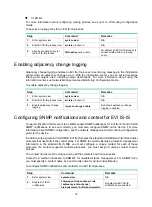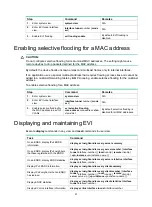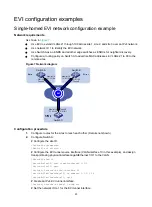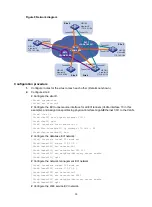
31
[Site4] interface tunnel 103 mode evi
[Site4-Tunnel103] source 172.16.4.1
[Site4-Tunnel103] evi network-id 3
[Site4-Tunnel103] evi extend-vlan 50 to 80
[Site4-Tunnel103] evi neighbor-discovery server enable
[Site4-Tunnel103] quit
# Enable EVI on GigabitEthernet 1/0/1.
[Site4] interface gigabitethernet 1/0/1
[Site4-GigabitEthernet1/0/1] evi enable
[Site4-GigabitEthernet1/0/1] quit
3.
Configure site 1:
# Configure the site ID.
<Site1> system-view
[Site1] evi site-id 1
# Configure the EVI tunnel source interface for all EVI tunnels (VLAN-interface 10 in this
example), and assign transport-facing physical interface GigabitEthernet 1/0/1 to the VLAN.
[Site1] vlan 10
[Site1-vlan10] port gigabitethernet 1/0/1
[Site1-vlan10] quit
[Site1] interface vlan-interface 10
[Site1-Vlan-interface10] ip address 172.16.1.1 24
[Site1-Vlan-interface10] quit
# Configure the network management EVI network.
[Site1] interface tunnel 102 mode evi
[Site1-Tunnel102] source 172.16.1.1
[Site1-Tunnel102] evi network-id 2
[Site1-Tunnel102] evi extend-vlan 4000
[Site1-Tunnel102] evi neighbor-discovery client enable 172.16.4.1
[Site1-Tunnel102] quit
# Configure the Web service EVI network.
[Site1] interface tunnel 103 mode evi
[Site1-Tunnel103] source 172.16.1.1
[Site1-Tunnel103] evi network-id 3
[Site1-Tunnel103] evi extend-vlan 50 to 80
[Site1-Tunnel103] evi neighbor-discovery client enable 172.16.4.1
[Site1-Tunnel103] quit
# Enable EVI on GigabitEthernet 1/0/1.
[Site1] interface gigabitethernet 1/0/1
[Site1-GigabitEthernet1/0/1] evi enable
[Site1-GigabitEthernet1/0/1] quit
4.
Configure all the other sites in the same way that site 1 is configured. Make sure extended
VLANs are correctly configured at each site. (Details not shown.)
Verifying the configuration
# Display neighbors registered with the ENDS in each EVI network.
[Site4] display evi neighbor-discovery server member
Interface: Tunnel101 Network ID: 1 Vpn-instance: [No Vrf]
IP Address: 172.16.4.1








































